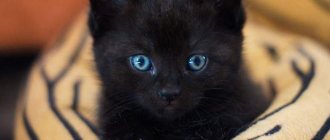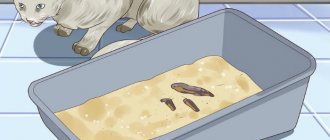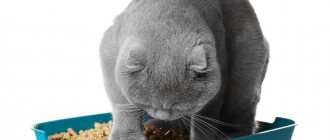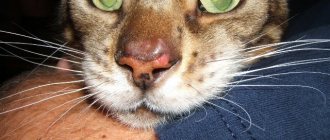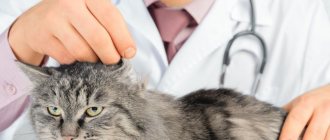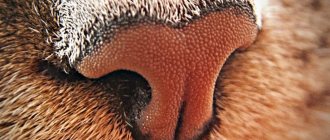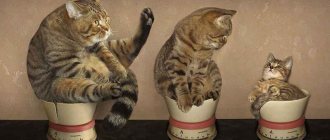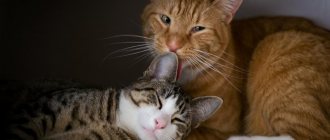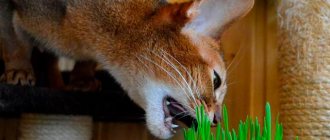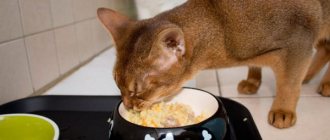Kitten at birth
Newborn sphinxes weigh 80-100 g with a body length of 10-12 cm. Like their furry counterparts, they are helpless - they are still blind and deaf. But already at the age of three days they are able to “get” food for themselves - to squeeze milk out of their mother’s nipples. For about a month it will be their main food, a source of antibodies for the formation of immunity.
Newborn hairless kitten:
7-12 months
In the next six months, if necessary, sphinxes undergo castration and sterilization. It's time for another vaccination against rabies and feline infections. The animals are transferred to adult food. The frequency of feedings is reduced to 2-3 times.
Sphynx cat at 9 months:
Canadian Sphynxes at 1 year:
Development table
Next are the standard indicators of kitten development, a table of weights by month.
| Age (months) | Weight, kg) |
| At birth | 0,08-0,1 |
| 1 | 0,5-0,6 |
| 2 | 1-1,2 |
| 3 | 1,5-1,8 |
| 4 | 2-2,5 |
| 5 | 2,5-3 |
| 6 | 2,5-3,2 |
| 7 | 2,5-3,8 |
| 8 | 2,5-4 |
| 9 | 2,5-4,2 |
| 10 | 2,5-4,3 |
| 11 | 2,5-4,5 |
| 12 | 2,5-5 |
The average weight of an adult Sphynx is 2.5-5 kg. Representatives of the breed are not large cats, so a large mass for them is not an indicator of health, but of obesity.
The owner must remember that a hairless cat needs to eat more than its furry counterparts. She spends more energy heating her naked body. The consequence of this is accelerated metabolism and increased appetite.
It is easy to determine the deficiency or excess mass of the Sphinx using these characteristics:
- Severe weight loss. The bones and joints of the animal are visible through the skin. The ribs protrude strongly, fat and muscle tissue cannot be palpated.
- Weight deficiency. The animal's ribs and pelvic bones are visible through the skin. Fat tissue - only on the chest.
- Normal weight. The bones are not visible, but they can be felt. The animal has a small layer of fatty tissue on its tummy.
- Excess weight. There is a thick layer of fatty tissue on the abdomen and chest. The cat's "waist" is not visible. The ribs, vertebral and pelvic bones are difficult to palpate.
- Severe overweight. The Sphinx becomes rounded, its belly resembles a bun. The fat layer is clearly visible. It is almost impossible to feel the bones.
We evaluate shapes and wool
There is another way to determine the age of a cat by external signs - assessing the condition of the coat and musculoskeletal skeleton. This is a very approximate method; it only allows you to determine whether the animal in front of you is young or already elderly.
Young pussies flaunt thick and shiny fur. Its villi are brightly colored; if there is a pattern, it is expressed quite clearly. Cats are lucky here too; they do not go bald with age, like humans. But the years make the coat thinner and duller. Gray hair becomes noticeable on dark skins.
Young pussies flaunt thick and shiny fur
An assessment of your overall physique will provide approximately the same amount of information. Teenagers are usually somewhat awkward, lanky and thin. Strong and flexible muscle relief is characteristic of active young animals. More mature individuals lose clear muscle definition, become rounder, heavier, and become “loose.” The muscles dry out, and old cats look thin and flabby, their shoulder blades protrude, and their backs sag.
Sometimes other methods are used. Have you heard how to determine the age of a cat by its paw pads? If in kittens they are very tender, silky, “untrodden”, then in older animals the skin of the pads gradually thickens, becomes a little coarser, and becomes a little rough. By the age of ten, the paw pads may even crack, especially if the cat has not had proper and nutritious nutrition.
More mature individuals lose clear muscle definition
Examples to what age cats can grow
When answering the question of how long cats grow, you should pay attention to the breed. Growth implies not only an increase in the external size of the cat, but also the formation of its internal organs and the entire body as a whole. The approximate total period for completing such a process, according to veterinarians, is 3 years for cats, 2 years for cats. Upon reaching this age, the appearance of animals, as a rule, does not change.
The timing of growth and development of cats is different for each breed.
Important! There is a variation in these terms depending on the breed of the pet. This is due to the fact that for each variety the process of formation of the endocrine system (pituitary gland) has different timing.
Regular
To what age do cats grow if they are ordinary? Domestic cats do not have set standards, as they are a mixture of different genotypes. They can grow as early as 1 year, while others, on the contrary, much later - only by 3 years.
"British"
Newborn kittens can weigh up to 140 g. By 9 months they grow very quickly and become sexually mature.
A British straight-eared cat at the age of 1 year weighs about 7 kg, and cats up to 5.5 kg. Then they continue to gain weight until 2.5-3 years and can reach a weight of up to 10-11 kg.
Note! Up to 2.5 years, the cat’s bones grow, and then the animal increases in width, building up muscles. General development ends by 3 years.
"British" can be raised up to 2.5 years
Sphinxes
Sphynx kittens are born tiny and helpless. Their birth weight is only 85 g. However, after 3 days they are able to feed on their mother’s milk on their own. Sphynxes are considered the smartest cats.
A Sphynx cat reaches puberty by 5–6 months. However, if the first mating takes place at this age, then the reproductive system stops working. Therefore, it is not recommended to mate a Sphynx before the age of 1 year. In general, their growth continues up to 2-2.5 years.
Sphynx growth ends after two years
Homemade
Domestic cats have their own developmental characteristics:
- the bulk is achieved by 2 years;
- much depends on heredity, nutrition and lifestyle;
- sedentary animals grow up to 9 kg.
How old do cats grow?
On average, cats grow up to 2-3 years of age, at this stage the accumulation of muscle mass ends.
How old do kittens grow?
Kittens usually grow until they are 1 year old, after which they enter adulthood.
Content recommendations
The answer to the question of how long cats grow depends largely on proper care. Owners need to create the most suitable conditions for their pets. First of all you need to:
- Maintaining hygiene is no less important for cats than for people. The pet must always be clean and well-groomed. Once a month, the cat needs to be bathed and thoroughly brushed. The cat's litter box should be emptied regularly and the filling should be changed, and the food bowl should be thoroughly washed several times a week.
- Once a quarter, helminthiasis prevention should be carried out. This is done with the help of special drugs. You can find out the exact name and dosage from your doctor.
- If the animal suffers from any chronic disease, it is necessary to regularly see the veterinarian. Take courses of treatment or prevention as prescribed.
- Comprehensive vaccinations against feline infections need to be updated annually. Thanks to this measure, the cat’s risk of contracting a viral, bacterial or fungal infection is reduced. This also applies to pets who do not leave the apartment. Owners can bring the infectious agent on shoes or clothing.
- Proper nutrition plays an important role. There are special cat foods with vitamin and mineral supplements on sale. If the animal eats natural products, medications are purchased separately.
- You should not expose your cat to unnecessary stress - yell at him, physically punish him, etc. Jealousy has a bad effect on the animal’s psyche.
- Early mating will not benefit the cat's health. If a pet becomes pregnant before a year, she may experience hormonal imbalances and developmental arrest. The female’s body will devote all its strength to bearing offspring, and the cat herself may become seriously ill or die from exhaustion.
Compliance with these conditions will help raise a healthy and strong animal that will delight the owner for many years.
Factors influencing growth
There are various factors that influence the growth of pets.
Genetics
It is quite rare for kittens to outgrow their parents in size. A big kitten for a small cat is very rare.
Gender of the animal
Cats are always bigger than cats.
Breed Features
To understand how old cats grow, it is necessary to consider the characteristics of the breed. This factor is the main one influencing the size of the animal.
Features of some breeds:
- Bengali Females grow up to 9 months, and males - up to 2 years;
- Maine Coon grows up to 2 years old, but becomes truly adult only at 3 years old;
- Scottish fold cats grow up to 2.5-3 years;
- Siberian cat - up to 1.5 years;
- sphinx - up to 2 years;
- bobtail - up to 2 years;
- outbred cats (domestic breeds), due to the fact that they belong to a mixed genotype, have different growth rates. Therefore, many stop growing as early as one year, while others can grow up to 3 years.
Presence of surgical interventions
Cats that are neutered later in life tend to be larger in size than cats that are not spayed and those that were spayed before the age of 1 year.
Past viral diseases
Important health factors include:
- the presence of parasites that cause poisoning of the body with toxins, help slow down the growth of the cat, as they suck out vitamins and nutrients;
- diseases of any nature (hereditary, infectious, somatic) negatively affect the development of certain organs of the animal;
- diseases of the endocrine system directly affect the development of the cat. Hormonal imbalances cause the pet to stop developing. Endocrine imbalance can also be caused by stress.
Lifestyle
The cat’s lifestyle includes factors such as:
- food quality. A deficiency of vitamins and vital substances helps to slow down growth processes and even stop them. Possible disproportionate development of the body;
- living conditions. Normal temperature conditions, normal lighting and compliance with the rules of hygiene and cleanliness of keeping the animal, high quality sleep and rest time stimulate the proper development of the cat;
- Lifestyle. Those animals that lead an active lifestyle grow much faster, their body is more proportional, and their weight meets the standards;
- mating age. By 8 months, male cats are considered mature.
Important! Early mating contributes to slower growth, sometimes even to cessation.
Lifestyle is an important factor in the growth and development of a pet
Regulation of sexual estrus
If the cat is purebred and the owner plans to get offspring from such a cat in the future, then it is recommended to breed him with cats that have a good pedigree. In some cases, breeders advise buying a female that has previously been sterilized (ligation of appendages). The cat will be ready to mate, but in this case there will be no offspring. It will be easier for the cat to cope with his natural instincts, finding an outlet for energy.
Another method that allows you to calm a cat during the mating season is the use of special hormonal drugs. All contraceptives are designed to artificially suppress an animal's desire to mate. In addition, when taking hormonal substances, signs of sexual desire decrease.
Medications for regulating sexual desire can be of plant or hormonal origin. Hormonal drops are widely used in home practice, giving an easy and quick effect, but not long-lasting. A large number of cat lovers believe that the use of oral contraceptives for cats in the form of drops or tablets is much more humane than sterilization or castration.
There is an opinion that this is a safer method of regulating sexual desire. Veterinary experts and scientists say that tablets and drops are a time bomb. A one-time use of a hormonal drug once a year (for example, in the spring) will not harm the body.
Systematic, constant use of drops can cause serious disorders in the animal’s body, including death. This is due to the fact that contraceptives for cats contain a dose of a hormonal substance that blocks the production of physiological hormones.
Constant impact on the endocrine system leads to serious disruptions in metabolic processes, and the risk of cancer increases significantly.
Veterinarians note that even for clinically absolutely healthy cats, the drug should be used with great caution. What can we say about cats with chronic diseases? Hormonal contraceptives for cats and cats have a pronounced progestational activity, having a negative effect on the hypothalamic-pituitary system
It is almost impossible to notice disturbances in the functioning of this part of the endocrine system in a timely manner. That is why, before you start giving your pet drops or tablets to prevent sexual desire, it is recommended to consult a professional
Hormonal contraceptives for cats and cats have a pronounced progestational activity, having a negative effect on the hypothalamic-pituitary system. It is almost impossible to notice disturbances in the functioning of this part of the endocrine system in a timely manner. That is why, before you start giving your pet drops or tablets to prevent sexual desire, it is recommended to consult a professional.
Stages of growth
There are several phases of growth in pets. The active growth phase usually lasts until the end of maturation, approximately 10-15 months (depending on the breed). Large breeds (for example, Maine Coons, Bengals, Servals) grow up to 2 years, and smaller ones - up to 3 years.
Important! At each stage of growth, the cat must be provided with favorable development conditions by the owner so that there are no developmental delays or deviations.
From birth to 4 days
This is the very first period from the moment the animal is born to 4 days. The period is called neonatal. The period is characterized by weight loss in babies.
Genetic abnormality
Very rarely, the reason that a kitten does not grow and does not gain weight can be a genetic anomaly, which results in dwarfism of the animal. As a rule, these are babies abandoned in early childhood by their mother cat, who have visible defects in skeletal development. Such a kitten does not grow due to underdevelopment caused by the mutation.
In conclusion, it only remains to add that, regardless of the cause of growth retardation, you should not self-medicate, especially if there is an infectious disease or the kitten is not growing due to pathology of the internal organs. At the first signs of illness, you should contact a veterinarian who will conduct a full examination and prescribe treatment.
Did you like the article and was it useful? Please share with your friends.
___________________________________
Why is my pet growing slowly?
To understand how long kittens grow, you need to pay attention to their lifestyle. There are many different factors that cause animal growth to slow down.
There are many reasons for a cat's slow growth
Care and habitat
Living conditions are very important for the development of a pet. Outdoor cats suffer significantly in development due to lack of proper care. This happens due to vitamin deficiency and weakened immunity.
Hormonal imbalance
Hormonal imbalances can slow down the development of an animal, but after some time it can begin to grow rapidly again. This is especially true for castrated males.
Presence of parasites in the body
If a kitten has worms, this will inevitably lead to slower growth. Worm infestations are dangerous for any pet of any age. The animal may even die.
Taking hormonal medications
Hormonal drugs, despite the prevalence of their use, can have a negative effect on the animal, slowing down its growth and development.
Important! The drugs can have a negative effect on the hormonal levels of purebred cats.
Passive lifestyle
It is known that pets leading a passive lifestyle grow more slowly, and their body may be disproportionate in development.
If a cat moves little, its muscular system stops growing, circulatory processes are disrupted, and concomitant diseases arise, for example, diabetes.
Important! Early mating can negatively affect the development of the pet.
Past viral diseases
Often, lack of weight is a consequence of past illnesses. Infections can affect a kitten’s fragile body, leading to disturbances in the gastrointestinal tract and deterioration in the absorption of substances. Organs do not receive enough nutrients from the blood, growth slows down and weight gain also slows down.
Selection of vitamins
A vitamin complex for a cat must be prescribed by a veterinarian. An excess of vitamins is just as dangerous as a deficiency. An adult cat's body requires a balanced content of vitamins and minerals to function properly.
- If the owner feeds the cat premium food, then the required amount of vitamins is already included in the composition; nothing needs to be added except a half dose of the anti-shedding agent.
- If a cat eats natural food or economy class food, it will need an additional vitamin source in the form of tablets.
- For adult cats, there is a general strengthening vitamin and mineral complex with biotin.
- If the cat is sterilized, suitable supplements are selected. There are also vitamins for pregnant and lactating cats. They support the mother’s body during pregnancy and lactation.
- For older cats, complexes are provided that slow down aging and speed up metabolism.
- Cats and cats constantly need protein, so to increase muscle mass, you can give food protein.
- You should always choose vitamin-mineral complexes with taurine - this is an essential amino acid on which almost the entire body of cats relies.
The growth and development of cats is a complex process. Owners must control it and promote the normal development of their pet.
What to do if the cat continues to grow
There are also opposite cases, the cat continues to grow, despite the fact that it has already crossed all age limits.
In this case it is necessary:
- understand the reasons for this phenomenon;
- put the animal on a diet;
- limit your diet to high-carbohydrate foods;
- encourage the cat to lead an active lifestyle;
- consult a veterinarian.
In order for a pet to grow properly, it is necessary to create favorable conditions for it: feed it with balanced food containing vitamins; maintain a temperature of at least 20 °C; from time to time, give anthelmintic drugs and fight skin parasites. Only then will the pet feel great.
To what age do cats grow, the parameters that the growth of a kitten of a certain breed must correspond to, in a given age period, factors influencing the growth processes.
Average age
The lifespan of a domestic cat, determined by genetic factors, ranges from 10 to 15 years, but long-livers live up to 20 years, which approximately corresponds to 100 years of human life.
If we compare human age with the age of a cat, then the age of a kitten at 1 month approximately corresponds to the age of a 6-month-old child and beyond:
- 2 months – 10 months;
- 3 months – 2 years;
- 4 months – 5 years;
- 5 months – 8 years;
- 6 months – 14 years;
- 7 months – 15 years;
- 8 months – 16 years;
- 1 year – 18 years;
- 3 years – 30;
- 5 years – 40;
- 8 years – 50;
- 10 years – 60;
- 12 years – 70;
- 18 years old – 80;
- 19 – 90;
- 20 – 100.
That is, for a cat, the age of 3-4 years is the average age by human standards.
Whether a pet belongs to a particular breed, to some extent, influences life expectancy.
For different breeds of domestic cats, these indicators are slightly different:
- Sphinxes, British - 15;
- Snow Shoe – 10;
- Persian breed - from 15 to 20;
- Asian longhaired cats – 18;
- Australian Longhair – 17;
- Siamese - 20;
- Russian Blues – 19.
Record-breaking animals
The largest cat whose result is recorded in the Guinness Book of Records is the Maine Coon Sweetie from the USA. At 5 years old, he had a length of 123 cm and a tail of 41.5 cm (by the way, Sweetie is also the owner of the longest tail among the representatives of his breed). The cat’s owners said that they didn’t feed their pet anything special, and his growth happened on its own.
Fiz Gel from the USA (Munchkin breed) is recognized as the smallest cat. Her height is only 15 cm. Despite her modest size, she is very mobile: she can easily jump on even the tallest objects.
The Persian Tinker Toy is considered the smallest cat. Its height is only 7 cm and its length is 19 cm. This growth of an adult animal is explained by genetic mutations. But this did not stop the animal from taking its place among the record holders in the book of records.
How old do kittens grow?
Like any living creature, the growth of a cat continues for a certain period - from birth until the complete formation of all tissues and organs, that is, until the physiological maturity of the body, which occurs somewhat later than puberty.
The intensity of growth from birth to full physiological maturity is not the same. Several periods can be distinguished:
- Neonatal – the first 3-4 days of life. During this period, the kitten’s body weight fluctuates and depends on how the pregnancy proceeded and how easy the birth process was.
- The suckling period lasts until the kitten is one month old. During this period, kittens steadily gain body weight.
- Transitional – from 1 to 2 months. There is a transition from milk feeding to food more suitable for a maturing animal. Body weight is subject to fluctuations at this time.
- After the suckling period , it begins at 7-8 weeks and continues until the complete cessation of growth, at the time of physiological maturity.
Peak active growth occurs at 4-6 months and continues until puberty. Further, to physiological maturity, the body “gets” in parameters, to the growth characteristic of the breed in accordance with the inherent heredity and conditions of keeping and feeding.
The duration of the growth period is influenced by the breed of the animal - large breeds grow somewhat longer than their smaller counterparts. Gender, heredity, and other external and internal factors matter.
What effect does belonging to a particular breed have on the growth of cats?
How do the British grow up?
Many cat lovers choose this breed. The British have a blue, plush-like coat, a funny expression on their face, and the same funny, playful character.
Cats gain weight up to 6 kilograms, sterilized up to 8. The weight of an adult cat is about 8 kg, and for neuters it can reach up to 10.
The growth period for cats extends to 2–3 years. The growth of cats usually ends by 1.5 years, or earlier if it is interrupted by pregnancy, after which the cat can gain weight.
How do sphinxes grow?
Due to the early onset of puberty, in cats of this breed - by 5-6 months, growth may stop at this age, due to the start of exploitation of the reproductive system. The growth of Sphynx cats can last up to 2.5 years.
The average weight of a cat is 2-4 kg, a cat is 4-6. Sphynx cats are prone to overeating, so you need to monitor their weight and diet. Since sphinxes have no hair, fatness is easy to determine visually.
How do Scottish Folds grow?
Kittens of this breed are distinguished by a calm, imperturbable, balanced character. The ears can droop, or they can remain erect, which is usually determined after weaning and is difficult to predict in advance, since lop-eared, according to breed standards, are necessarily crossed with “straight-eared” brothers.
Growth parameters coincide with those of the British cat breed - growth ends by the age of three, the average weight of adult cats reaches 8 kg, cats usually do not exceed 6 kg.
How Maine Coons grow
The Maine Coon breed comes from North America. Representatives of the breed are considered the largest representatives of domestic cats. Although the weight of an adult castrated cat rarely exceeds 10 kg, the abundance of hair, powerful paws and bones visually almost double the size of the cat.
The length of the body, from the tip of the tail to the tip of the nose, is 1m 23 cm - this is a breed record. The body weight of a castrated male reaches 12 kg.
As representatives of a large breed, kittens take a long time to grow. Growth is most intense in the first year of life. By 4 months of age, the kitten looks like an adult cat of smaller breeds and weighs approximately 4 kg. As the year approaches, growth slows down a bit. Maine Coons stop growing by the age of 3-5 years; by this time the weight of an adult cat can be about 12 kg, females 8.5 kg.
How do Siberian cats grow?
The cat breed originates from the northern regions of Western Siberia and the Urals. Cats of the Siberian breed are distinguished by good health and a strong physique, which is typical for naturally formed breeds. Outwardly they resemble Norwegians, but unlike them, they are more massive, have a wider head and a low body. The weight of a cat is up to 6 kg, a cat – up to 6-10 kg. Growth continues up to 2-3 years.
How to choose a kitten that will grow large?
First, you need to find a breeder of large-breed animals with extensive experience and a convincing reputation in order to purchase a suitable kitten from him. The animal must:
- be a purebred representative of your breed, which would be confirmed by metrics;
- have good health and vaccinations according to age. Notes about this should be looked for in veterinary documents;
- be at least two months old. Experts believe that for full development, a kitten must feed on mother’s milk up to this age;
It is advisable to choose a male animal, ideally the largest in the litter
It is worth paying attention to parents. Not all large breeds grow big and heavy.
Heredity in this matter is one of the determining factors.
When choosing a kitten, the future owner's eyes widen
Then everything is simple. You should take proper care of your pet and feed it well, not allow it to wander on its own, and also contact the clinic in a timely manner if your pet gets sick.

